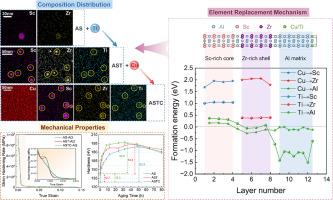Influence of Cu and Ti microalloying on the multiscale microstructure evolution and mechanical properties of 7xxx alloys
IF 11.2
1区 材料科学
Q1 MATERIALS SCIENCE, MULTIDISCIPLINARY
引用次数: 0
Abstract
Introducing trace rare earth elements (REEs) into L12 dispersoids (Al3(Sc,Zr)) can markedly enhance the mechanical properties of aluminum alloys, However, excessive amounts may cause adverse impacts. This study explores Ti and Cu as transition metal candidates for Al-Zn-Mg-X alloys, aiming to enhance mechanical properties, elucidate microstructure evolution, and identify optimization mechanisms. The addition of Ti to the Al-6.8Zn-2.2Mg-0.2Sc-0.1Zr (AS) alloy results in a notable refinement of the grain size, reducing it from 170 μm to 47 μm. This refinement of Ti can be attributed to its role as a nucleating agent during solidification, its promotion of dynamic recrystallization during hot-rolling, and its inhibition of static recrystallization during solid solution treatment stage. The formation of a new Ti-containing layer, which substitutes Al sites adjacent to Al3Zr dispersoids, leads to an increase in the phase size from 16 nm to 25 nm. In addition, Cu significantly decreases the aging activation energy of the GP zone and η’ precipitate, thereby facilitating their nucleation and growth, which enhances the mechanical properties of the alloy. Ti markedly improves the hardness and strength of the alloy through grain refinement strengthening, Orowan strengthening and solid solution strengthening, while Cu predominantly enhances solid solution strengthening. Our findings suggest that Ti and Cu microalloying profoundly influences the properties and the microstructures of Al-Zn-Mg-X alloys across various scales offering a promising approach for the advancement of high-performance aluminum alloys.

铜和钛微合金化对 7xxx 合金多尺度微结构演变和机械性能的影响
在 L12 分散体(Al3(Sc,Zr))中引入痕量稀土元素 (REE) 可以显著提高铝合金的机械性能,但过量的稀土元素可能会造成不良影响。本研究将 Ti 和 Cu 作为 Al-Zn-Mg-X 合金的候选过渡金属,旨在提高机械性能、阐明微观结构演变并确定优化机制。在 Al-6.8Zn-2.2Mg-0.2Sc-0.1Zr (AS) 合金中加入 Ti 后,晶粒尺寸明显细化,从 170 μm 减小到 47 μm。钛的细化可归因于它在凝固过程中作为成核剂的作用、在热轧过程中对动态再结晶的促进作用以及在固溶处理阶段对静态再结晶的抑制作用。新的含钛层的形成取代了邻近 Al3Zr 分散体的 Al 位点,导致相尺寸从 16 nm 增加到 25 nm。此外,Cu 能显著降低 GP 区和η'沉淀的时效活化能,从而促进它们的成核和生长,从而提高合金的机械性能。钛通过晶粒细化强化、奥罗旺强化和固溶强化明显提高了合金的硬度和强度,而铜则主要提高了固溶强化。我们的研究结果表明,Ti 和 Cu 微合金化对 Al-Zn-Mg-X 合金在不同尺度上的性能和微观结构产生了深远的影响,为高性能铝合金的发展提供了一种前景广阔的方法。
本文章由计算机程序翻译,如有差异,请以英文原文为准。
求助全文
约1分钟内获得全文
求助全文
来源期刊

Journal of Materials Science & Technology
工程技术-材料科学:综合
CiteScore
20.00
自引率
11.00%
发文量
995
审稿时长
13 days
期刊介绍:
Journal of Materials Science & Technology strives to promote global collaboration in the field of materials science and technology. It primarily publishes original research papers, invited review articles, letters, research notes, and summaries of scientific achievements. The journal covers a wide range of materials science and technology topics, including metallic materials, inorganic nonmetallic materials, and composite materials.
 求助内容:
求助内容: 应助结果提醒方式:
应助结果提醒方式:


